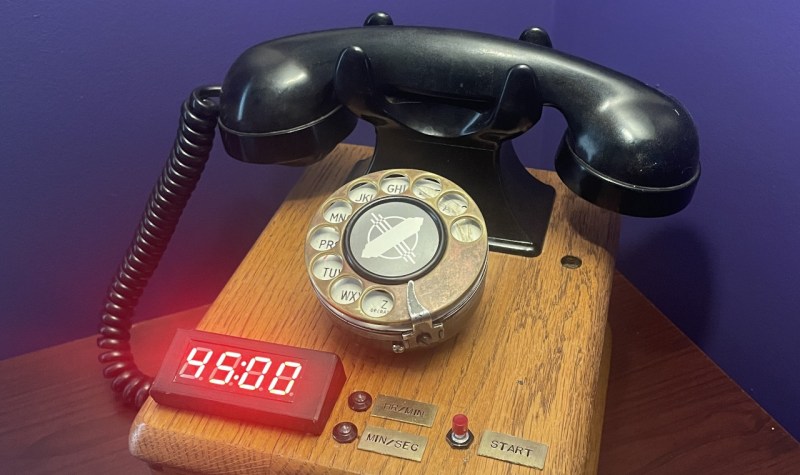It’s safe to say that few people still use rotary phones on a daily basis. Hell, most of us don’t even use landline telephones anymore. But just because these classic phones are no longer being used for their original purpose doesn’t necessarily mean they’re doomed to become e-waste.
[Scott-28] recently sent in a particularly well-documented project that turned an antique rotary phone into a digital kitchen timer using an internal Arduino. While we’re not sure practical is a word most folks would use to describe the resulting device, it’s certainly a conversation starter, and the details on how it was all implemented make for an interesting read.
As explained in the README, [Scott-28] first used an oscilloscope to figure out the pulses generated by the phone’s dial. From there, it was relatively easy to connect the dial to one of the pins on an Arduino Uno to determine which numbers the user had entered. The trickier part was getting the original bells to work — in North America, it takes up to 90 VAC to get a phone’s ringer going, which is quite a bit more than the lowly Arduino can handle.
 Luckily, he was able to source an LS057020 “Black Magic” ring generator from Cambridge Electronics Laboratories. All you need to do is give it 5 volts DC, and it produces the necessary ring signal. [Scott-28] does note that the gadget makes a lot of electrical noise when in operation, but seems a small price to pay given how much complication it saves in the design.
Luckily, he was able to source an LS057020 “Black Magic” ring generator from Cambridge Electronics Laboratories. All you need to do is give it 5 volts DC, and it produces the necessary ring signal. [Scott-28] does note that the gadget makes a lot of electrical noise when in operation, but seems a small price to pay given how much complication it saves in the design.
With rotary decoding and the ringer settled it was just a matter of writing some code to glue it all together. Into the mix, [Scott-28] added a seven-segment LED display to show the current time, a couple of LEDs to indicate if the digits are hours, minutes, or seconds, and a button to kick the whole thing off. When the counter gets to zero, the ringer goes off, and as you’d expect, picking up the phone’s handset stops it.
We’ve seen hackers interface with rotary phones before, with some even turning them into virtual assistants. Plus, who could forget the development of the incredible rotary cellphone? Despite being old technology by even graybeard standards, it seems the rotary dial is either unwilling or unable to fade into obscurity, which is fine by us.
















Initially, I cringed over the destruction of what might have been a cool vintage phone, until I saw the project photos… somebody had already butchered/Frankenstein-ed this thing a long time ago.
As a matter of aesthetics, I don’t think a glaring LED display “works” with brass bells, an oak box, a bakelite handset, and a dial. This combination is the stylistic equivalent of oil and water.
I think a better implementation would have utilized the dial, hand set, and hook switch for all functions: For example, lift the receiver, dial 1 for minutes, dial 2 for seconds, (with a confirmation beep from the headset) and then dial in the desired duration. Dial 0 to start the timer. Generate a long beep in the headset every 5 minutes, then a shorter beep every minute, then a very short beep every second for the last 10 seconds (this would easily be audible with the handset lying on the counter). Or, generate “ticks” at every second and a marker tone on the minute…. there are infinite variations on the idea. At timeout, ring the bells until the person hangs up (which would cancel everything and turn off the power.
The point is, even the button and the indicator lamps (which are also aesthetically dissonant) could have been eliminated.
All that said, I applaud any time somebody builds something, especially if they can repurpose something someone else has already ruined, and make something useful of it.
Fun project.
Yes, the LED’s are a bit jarring to me. But, that aside, I like the overall implementation. Sure, I think I might have done it differently, but I’d likely never be done. This one is done. That makes it better than any approach I would have taken.
If I were given the task of “improving” the aesthetics of the project, I’d consider cutting a recess into the wood to fit a small e-paper display. The typeface used on the display could likely be made to resemble the style of the characters in the dial holes. A brass bezel, aged to resemble the dial, most likely with radiused inside and outside corners, would finish off the recess. Possibly a slightly yellowish/brownish tinted, scratched up filter could be placed over the e-paper display to make it look aged.
I canibalised a faux-antique rotary phone and turned it into a counting toy for my grandkids. The LED display counted each dial pulse and displayed the total, cleared it when the dial was turned again. A switch controlled whether the display cleared, added or subtracted the next digit dialled from the previous total.
Nice idea, there is also an implementation where this is done totally in audio through the phone horn: https://github.com/ralphcrutzen/PTT-Tafeltjes-Telefoon
I think nixie tubes would be esthetically pleasing